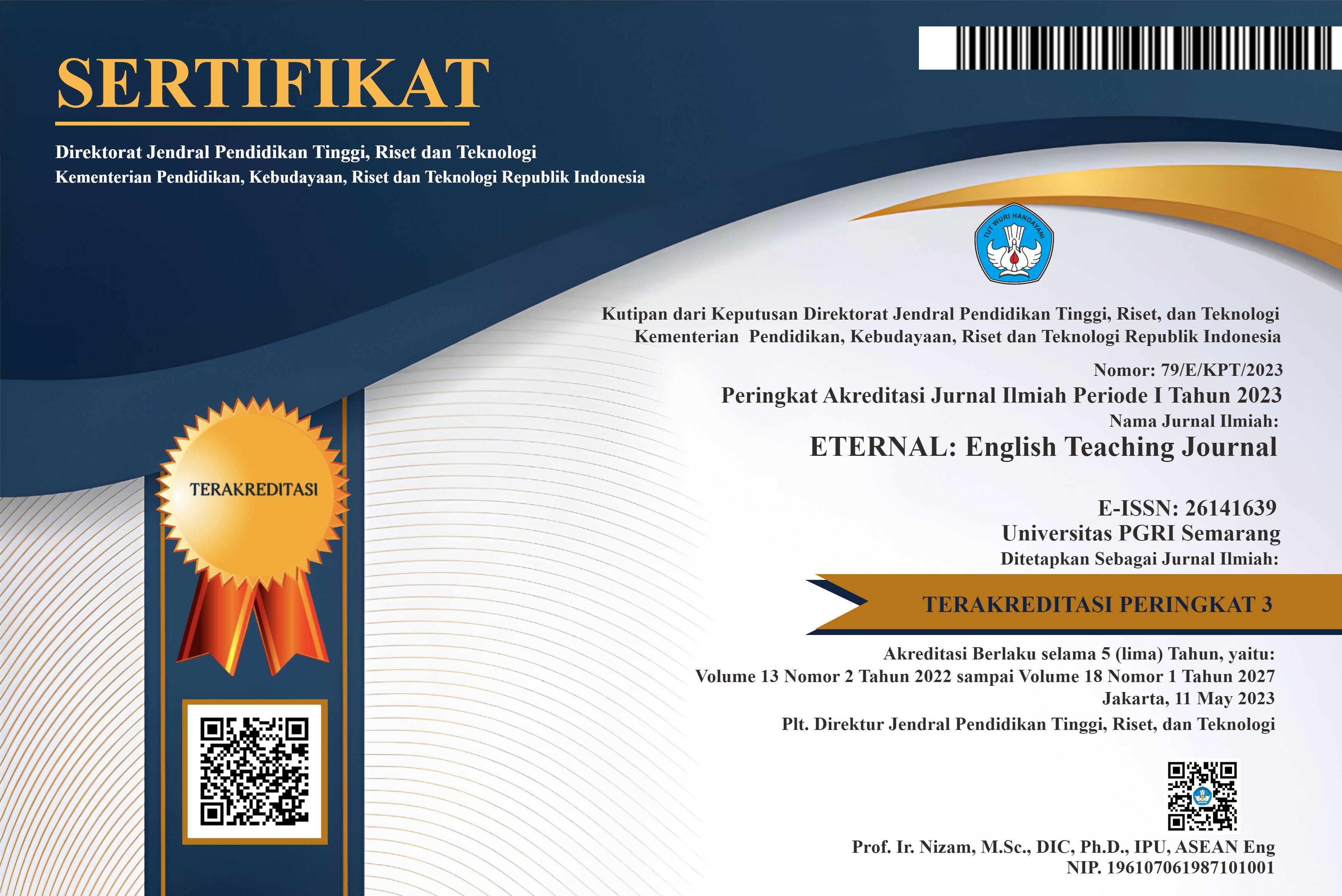Analysis of Higher Order Thinking Skills (HOTs) in English Final Examination Questions at Junior High School
DOI:
https://doi.org/10.26877/eternal.v16i1.892Keywords:
Bloom’s taxonomy, Higher Order Thinking skills, English testAbstract
The development of students' Higher Order Thinking Skills (HOTs) is emphasized in the Indonesian educational system. The aim of this research was to examine the HOTs found in the English final exam questions for the 2023–2024 academic year at private schools in Yogyakarta. The test questions were categorized into higher-order thinking skills (HOTs) and lower-order thinking abilities (LOTs) using the updated Bloom's taxonomy framework. The purpose of this study is to determine how much final examination questions at private junior high schools for the academic year 2023–2024 foster higher-order thinking abilities and to pinpoint areas that could use development in order to better support the curriculum objectives. Qualitative content analysis design was used in this research. The data resources of this research were the final exam test questions for the academic year 2023–2024. The revised Bloom’s taxonomy framework was used to analyze the data. The findings of this research indicated that the test questions demand more HOTs-type questions since the exams are predominantly LOTs-type questions. Most of the test questions (46.7%) are about applying questions, followed by comprehending (37.8%) and analysis (15.5%). The results revealed that the exam questions lacked HOTs-type questions.
References
Aditomo, A., Syahril, I., Yuliati, K., Suryani, N., Handayani, F., Muhammad, H., & Zulfikri. (2024). Kurikulum Merdeka. Pusat Kurikulum dan Pembelajaran, Badan Standar, Kurikulum, dan Asesmen Pendidikan, Kementerian Pendidikan, Kebudayaan, Riset, dan Teknologi.
Akbariah, Y. (2018). Cognitive Skills in Summative Test Items of Secondary Vocational Schools Across Curriculum (School-Based Curriculum and Curriculum 2013) (Doctoral dissertation, Diponegoro University).
Anderson, L. W., & Krathwohl, D. R. (2001). A Taxonomy for Learning, Teaching and Assessing: A Revision of Bloom’s Taxonomy of Educational Objectives: Complete Edition. New York: Longman.
Brookhart, S. M. (2010). How to Assess Higher-Order Thinking Skills. Educational Leadership, 67(6), 34-39.
Creswell, J. W. (2002). Educational research: Planning, conducting, and evaluating quantitative. Upper Saddle River, NJ: Prentice Hall.
Driana, E., & Ernawati, E. (2019). Teachers’ understanding and practices in assessing higher order thinking skills at primary schools. Acitya: Journal of Teaching and Education, 1(2), 110–118. https://doi.org/10.30650/ajte.v1i2.233
Ernawati, E. (2023). Analisis Soal Ujian Matematika Berkategori Higher Order Thinking Skills (HOTS) Siswa SMP dengan Analisis Rasch Model. Jurnal Didaktika Pendidikan Dasar, 7(1), 277-294. doi: https://doi.org/10.26811/didaktika. v7i1.1027
Feng, Z., & Wei, W. (2019). Study on Cultivating Students’ Critical Thinking Ability Through Higher Order Questioning. Proceedings of the 4th International Conference on Contemporary Education, Social Sciences and Humanities (ICCESSH 2019). https://doi.org/10.2991/ICCESSH-19.2019.170.
Freahat, N. M., & Smadi, O. M. (2014). Lower-order and higher-order reading questions in secondary and university level EFL textbooks in Jordan. Theory and Practice in Language Studies, 4(9), 1804-1813. https://doi.org/10.4304/tpls.4.9.1804-1813
Gareis, C., & Grant, L.W. (2015). Teacher-Made Assessments: How to Connect Curriculum, Instruction, and Student Learning (2nd ed.). Routledge. https://doi.org/10.4324/9781315773414
Gil-Glazer, Y. A., Walter, O., & Eilam, B. (2019). PhotoLingo—Development and Improvement of Higher-Order Thinking and Language Skills Through Photographs. Journal of Education, 199(1), 45-56. https://doi.org/10.1177/0022057419843523
Harahap, A., & Astrid, A. (2021). Boosting Classroom Interaction Based on Higher Order Thinking Skills (HOTS) in English Learning for Beginners. International Journal of Language Education, 5(1), 477-489. doi: https://doi.org/10.26858/ijole.v5i1.15211
Heyde, V. V. D., & Siebrits, A. (2019). Higher-order e-assessment for physics in the digital age using Sakai. The Physics Teacher, 57(1), 32-34. https://doi.org/10.1119/1.5084925.
Ilham, N. W., Jabu, B., & Korompot, C. A. (2020). analysis of higher-order thinking skills (HOTS) items in senior high school english national examination 2019. ELT Worldwide, 7(2).
Javaeed, A. (2018). Assessment of Higher Ordered Thinking in Medical Education: Multiple Choice Questions and Modified Essay Questions. MedEdPublish, 7. https://doi.org/10.15694/mep.2018.0000128.1.
Krathwohl, D. R. (2002). A Revision of Bloom’s Taxonomy: An Overview. Theory Into Practice, 41(4), 212–218. https://doi.org/10.1207/s15430421tip4104_2
Morrison, D. (2018). The SQE and creativity: a race to the bottom? The Law Teacher, 52(4), 467-477. https://doi.org/10.1080/03069400.2018.1530337
Narwianta, N., Bharati, D. A. L., & Rukmini, D. (2019). The evaluation of higher order thinking skills in English school nationally standardized examination at state senior high school 6 Semarang. English Education Journal, 9(3), 316-326. https://doi.org/10.15294/eej.v9i3.30937
Nguyễn, T. M. T., & Nguyễn, T. T. L. (2017). Influence of explicit higher-order thinking skills instruction on students’ learning of linguistics. Thinking Skills and Creativity, 26, 113-127. https://doi.org/10.1016/j.tsc.2017.10.004
Putra, T. K., & Abdullah, D. F. (2019). Higher-order thinking skill (HOTS) questions in English national examination in Indonesia. The Journal of Educational Development, 7(3), 178-185. https://doi.org/10.15294/jed.v7i1.30878
Qasrawi, R., & BeniAbdelrahman, A. (2020). The Higher and Lower-Order Thinking Skills (HOTS and LOTS) in Unlock English Textbooks (1st and 2nd Editions) Based on Bloom's Taxonomy: An Analysis Study. International Online Journal of Education and Teaching, 7(3), 744-758.
Sausan, K., Rohmatillah, R., & Rini, Y. P. (2023). HOTS Based on Revised Bloom's Taxonomy: Analysis in English Examination Test Items Used in High School Level. English Education: Jurnal Tadris Bahasa Inggris, 16(1), 102-118. doi: https://doi.org/10.24042/ee-jtbiv16i1.16103
Schulz, H. W., & FitzPatrick, B. (2016). Teachers’ Understandings of Critical and Higher Order Thinking and What This Means for Their Teaching and Assessments. Alberta Journal of Educational Research, 62(1), 61–86. https://doi.org/10.11575/ajer.v62i1.56168
Tyas, M. A., Nurkamto, J., & Marmanto, S. (2020). Cultivating Students' Higher-Order Thinking Skills in EFL Classes: The Role of the Teacher and the Textbook. International Online Journal of Education and Teaching, 7(1), 267-276.
Virranmäki, E., Valta-Hulkkonen, K., & Pellikka, A. (2020). Geography tests in the Finnish matriculation examination in paper and digital forms–an analysis of questions based on revised Bloom’s taxonomy. Studies in Educational Evaluation, 66, 100896. https://doi.org/10.1016/j.stueduc.2020.100896
Wilson, L. O. (2016). Anderson and Krathwohl Bloom’s taxonomy revised understanding the new version of Bloom’s taxonomy. The Second Principle, 1(1), 1-8.
Wisrance, M. W., & Semiun, T. T. (2020). LOTs and HOTs of teacher-made test in junior high school level in Kefamenanu. JEE (Journal of English Education), 6(2), 62-76. https://doi.org/10.30606/jee.v6i2.574
Yudha, R. P. (2023). Higher Order Thinking Skills (HOTS) Test Instrument: Validity and Reliability Analysis with The Rasch Model. EduMa: Mathematics education learning and teaching, 12(1), 21-38. doi: https://doi.org/10.24235/eduma.v12i1.9468







